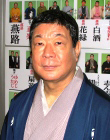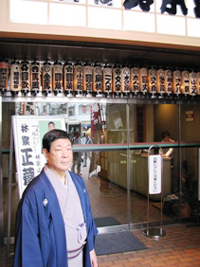Top>People>Teaching rakugo in America
 Index
Index

Mr. Sankyo Yanagiya[Profile]
Teaching rakugo in America
Mr. Sankyo Yanagiya
Rakugo performer
Rakugo (Japanese comedy) performer Sankyo Yanagiya, 63 years old, is an expert wordsmith, mesmerizing fans at packed comedy shows while also teaching Japanese language at a university in Vermont, a state located in northeast America. Sankyo graduated from Chuo University Senior High School at Koganei. He discussed his dream of becoming a Chuo University student, his aspiration to become an teacher, and why his life path changed.
Dream of becoming a Chuo University student
――Why did you choose Chuo University?
A main reason that I selected Chuo University is that I knew a young man from Kagoshima who attended the school. This young man was employed at a small iron shop next to my family home (Honjo, Sumida Ward, Tokyo), working during the day and attended night school at Chuo University in the evening. My family runs a western-style restaurant and we used to serve breakfast costing from 200 to 300 yen for workers. After finishing work, the young man would eat again at our restaurant and then go to Chuo University. At the time, there were many such struggling students. To me, the young man was the ideal older brother and his presence gave me the dream of attending Chuo University. I had the wishful thinking that my entrance would be assured if I attended the affiliated high school. Also, my dream was to be a school teacher in the future.
At that time, student demonstrations were particularly intense and I was forced to abandon my dream of attending university. Now, I feel like those student demonstrations helped me to discern my path. My academic record was towards the bottom of the class and my teachers were worried about my future. That's when I casually said, ok, I'll become a rakugo performer. Although I only said it to assuage my teacher's concern, I now feel like that statement was the instant that I made up my mind. I think that it had always been my dream to speak or perform in front of people. When reflecting back on my younger years, I think that I had such a latent desire.
Teaching Japanese language is a learning experience
――You have been teaching Japanese to university students in America for 7 years, right?
The professors teach proper Japanese, so we teach rakugo as an educational material. I hope that students will remember Japanese through rakugo. In America, a female university student asked me a question using extremely formal keigo, or Japanese honorific language. I thought that her question was a little too polite, so I told her a slightly less formal phrase to use. I explained that although her Japanese was not mistaken, no one in Japan speaks with such great formality.
Students listen to rakugo during classes. Through rakugo, I hope that they will understand the metaphors and expressions used in short Japanese sentences. For example, the Japanese word baka is not only used to call someone stupid. It can also be used affectionately between acquaintances as a way of poking fun at each other.
Foreign students are highly creative

――I've heard that foreign students perform rakugo in Japanese.
I stop telling the rakugo story Akubi Shinan (Yawn Mentor) halfway through and have students think of the continuation. ≪A disciple of yawning brings his friend to a training studio for yawning. The friend is kept waiting for a long time and yawns with boredom. The teacher is impressed by the friend's yawning and tells the disciple that "your friend is better at yawning than you.".≫
As a continuation, foreign students think of interesting scenarios that are different than the existing Akubi Shinan. For example: "The disciple learning to yawn becomes discouraged at his inability. The next day, when riding in a boat, he gently yawns while in a daze. He then regrets not having made such a yawn the previous day." Another foreign student thought of this scenario: "The disciple accidentally sneezed during the lesson of yawning. The mentor then says that sneezing is taught next door."
Last year, I was really impressed by students' continuation to the story called Zoro-Zoro (In Droves). ≪The owner of an unpopular barber shop assumes the guise of a lucky acquaintance and goes to pray at a shrine. Afterwards, the barber shop is filled with droves of customers. The owner is overjoyed and goes to shave the whiskers of a certain customer when.≫
One student thought of the following continuation: "A wife who hasn't been blessed with children goes to the shrine to pray for children. She gets pregnant and goes to the hospital to give birth. Babies come out on after another, in droves!" Another student imagined the following scenario: "A shop selling bean-jam cakes has no customers. The shop owner goes to the shrine and prays that everyone will eat the bean-jam cakes. The next day, the store is flooded with droves of customers who are screaming for cakes. The shop owner was grateful for his good luck. However, after about one month, customers suddenly stopped coming. Puzzled by the sudden lack of business, the shop owner went into town only to see droves of diabetic patients." These are such creative continuations to the story. Even more, the students create these scenarios in Japanese.
Foreigners speaking proper Japanese
――I guess you were really surprised?
Students in America have remembered a comedic skit in which a foreigner asks a Japanese person about eel cooking. ≪"Is this eel dish Chinese style or Japanese style?" "Neither is correct. This is Yoshoku.≫ (In this scene, the Japanese word Yoshoku, which has at least two meanings of western dish and farmed products, indicates that the eel dish is Western style or farmed eel is used for the dish.)
The foreign students tell this story in natural, proper Japanese. However, when Japanese rakugo performers tell this story, they conform to the Japanese image of foreigners and speak in an unnatural intonation. However, foreign students are trying to use proper Japanese, so they don't tell the story using unnatural intonation. Furthermore, when Japanese people speak with foreigners, we tend to speak slowly and carefully enunciate each syllable. This is a bad way of interacting. We should speak naturally and with proper pronunciation. If we don't speak properly, it will have a bad influence on foreigners trying to learn Japanese.
We should also avoid using abbreviated Japanese when speaking with foreigners. It is necessary to use full phrases in order to ensure understanding. For example, the word Domo could mean Domo Arigatou [Thank you very much] or Domo Sumimasen-deshita [I'm so sorry], so when you convey thankfulness or apologize to someone, it is better not to use abbreviated words in order to communicate effectively. I learned these kinds of things while interacting with foreign speakers. In November, I will have the opportunity to visit universities in Paris (France), Prague (Czech Republic) and Budapest (Hungary). As I get older, I have started to think of Japanese language education as my lifework. My position as a teacher is one of studying together with my students. I feel like I have somewhat fulfilled by dream of becoming a teacher. Although my dream was interrupted, it seems that the small seeds of my dream blossomed while I was pursuing another path.
- Sankyo Yanagiya
-
Real name: Minoru Inaba. Born in Honjo, Tokyo on August 4th 1948. 63 years old. After graduating from Chuo University Senior High School at Koganei, entered an apprenticeship under Kosan Yanagiya V in 1967, taking the stage name of Koina. In November 1972, was promoted to the rank of futatsume and changed his name to Sankyo. Promoted to shinuchi (star performer of rakugo) in 1981.
Has won numerous awards, including the National Arts Festival Prize. Permanent member of the Rakugo Association. Hobbies include Japanese dance and creative cooking. Has won the Drama Appreciation Award. His family operates Kitchen Inaba, a popular neighborhood restaurant in Azuma-Bashi, Honjo.
- Research Activities as a Member of Research Fellowship for Young Scientists (DC1), Japan Society for the Promotion of Science (JSPS) Shuma Tsurumi
- Important Factors for Innovation in Payment Services Nobuhiko Sugiura
- Beyond the Concepts of Fellow Citizens and Foreigners— To Achieve SDGs Goal 10 “Reduce Inequality Within and Among Countries” Rika Lee
- Diary of Struggles in Cambodia Fumie Fukuoka
- How Can We Measure Learning Ability?
—Analysis of a Competency Self-Assessment Questionnaire— Yu Saito / Yoko Neha - The Making of the Movie Kirakira Megane








